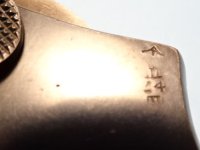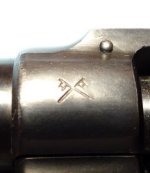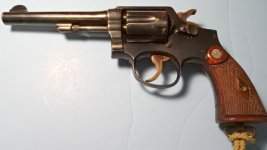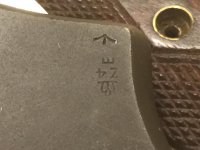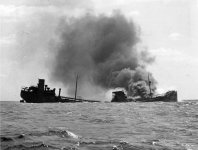grendelbean
US Veteran
Submitted for inclusion into the database...
Found this early BSR recently and couldn’t resist adding it to my accumulation. A very nice bright blued S&W Hand Ejector Model M&P 1905 4th Change with 5” barrel in .38 S&W CTG caliber with correct stocks and matching serial numbers in all five places. Serial 782133. The thing that caught my interest particularly was that the revolver has only British War Office (Military) markings – that is to say only crossed guide on flags (viewing or inspection mark) at the left side front of the frame (not deactivation mark) and a broad arrow, crown, Z4 inspector’s stamp, and an “E” on its’ side (for Enfield, where inspections were done at the Royal Small Arms Factory).
Other than the original factory standard markings there are no others on the revolver. No British civil proof marks, no import markings, no other military stamps or marks. I believe this gun preceded the Lend Lease category and was a direct sale to the British Purchasing Commission. Lend Lease guns were property of the U.S. and did not require British Proofing of any sort.
The other point of interest was that there is remarkably little wear visible on the gun. The muzzle crown bluing is worn to silver, there is a single worn spot over one chamber of the cylinder only, and the backstrap bluing is worn down to almost silver.
These things made me wonder and piqued my imagination. I suspect the revolver was carried in a British standard P37 holster and rarely removed. No finish removal typical of holster wear and use – just the crown of the muzzle where it rests on the bottom of a P37 holster, on the very crest of the round cylinder where it rested against the holster and apparently seldom turned, and the extensively worn backstrap, where the flap of a British P37 holster rides. That flap fits kind of snugly down over the backstrap and in time might well have rubbed on the backstrap long enough to wear away the bluing. Who would carry a service revolver in this manner? A staff officer, never seeing field service? A politician occasionally appearing in uniform? It just made me wonder, and your guess is as good as mine.
Anyway, I think I have a great example of a classic early British Service Revolver without London or Birmingham post war proof marks, and in remarkably good condition. I like it. If anyone can add or correct any of my interpretations I would sure appreciate it. This forum is a really great source of knowledge. Thanks.
Found this early BSR recently and couldn’t resist adding it to my accumulation. A very nice bright blued S&W Hand Ejector Model M&P 1905 4th Change with 5” barrel in .38 S&W CTG caliber with correct stocks and matching serial numbers in all five places. Serial 782133. The thing that caught my interest particularly was that the revolver has only British War Office (Military) markings – that is to say only crossed guide on flags (viewing or inspection mark) at the left side front of the frame (not deactivation mark) and a broad arrow, crown, Z4 inspector’s stamp, and an “E” on its’ side (for Enfield, where inspections were done at the Royal Small Arms Factory).
Other than the original factory standard markings there are no others on the revolver. No British civil proof marks, no import markings, no other military stamps or marks. I believe this gun preceded the Lend Lease category and was a direct sale to the British Purchasing Commission. Lend Lease guns were property of the U.S. and did not require British Proofing of any sort.
The other point of interest was that there is remarkably little wear visible on the gun. The muzzle crown bluing is worn to silver, there is a single worn spot over one chamber of the cylinder only, and the backstrap bluing is worn down to almost silver.
These things made me wonder and piqued my imagination. I suspect the revolver was carried in a British standard P37 holster and rarely removed. No finish removal typical of holster wear and use – just the crown of the muzzle where it rests on the bottom of a P37 holster, on the very crest of the round cylinder where it rested against the holster and apparently seldom turned, and the extensively worn backstrap, where the flap of a British P37 holster rides. That flap fits kind of snugly down over the backstrap and in time might well have rubbed on the backstrap long enough to wear away the bluing. Who would carry a service revolver in this manner? A staff officer, never seeing field service? A politician occasionally appearing in uniform? It just made me wonder, and your guess is as good as mine.
Anyway, I think I have a great example of a classic early British Service Revolver without London or Birmingham post war proof marks, and in remarkably good condition. I like it. If anyone can add or correct any of my interpretations I would sure appreciate it. This forum is a really great source of knowledge. Thanks.
Attachments
Last edited:

